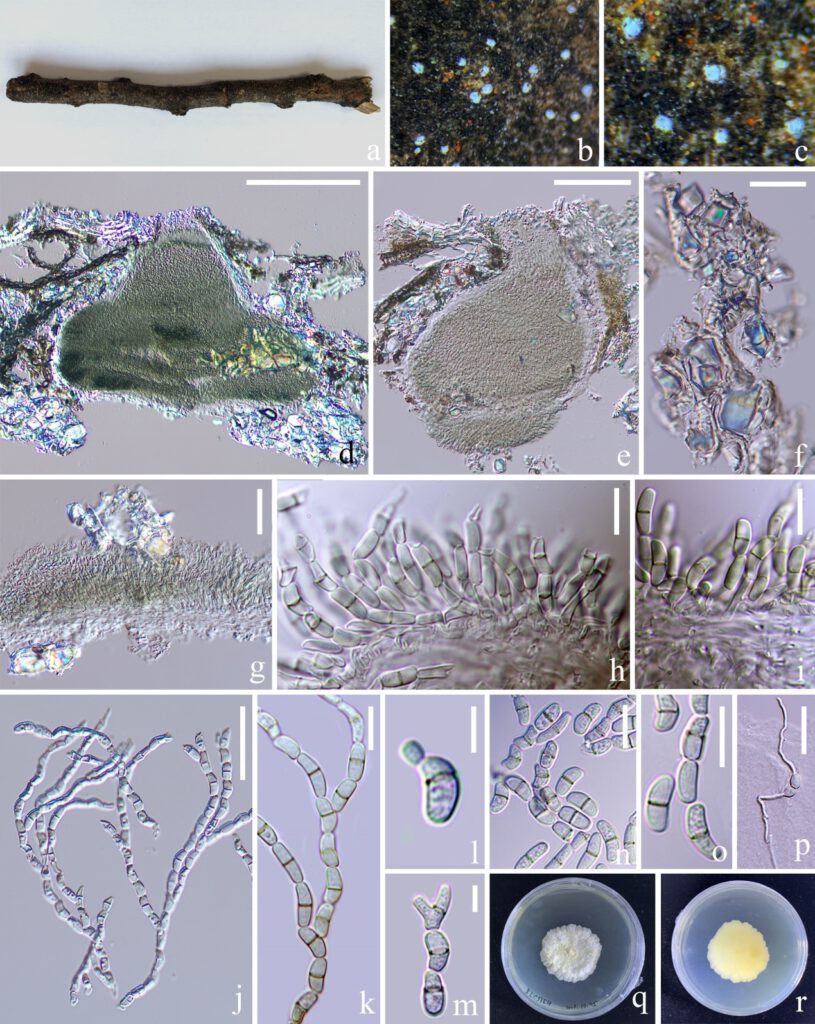Neohormodochis septispora D. P. Wei & K. D. Hyde, sp. nov.
MycoBank number: MB; Index Fungorum number: IF; Facesoffungi number: FoF 12298;
Etymology: The epithet “septispora” refers to the septate conidia.
Holotype: China, Yunnan Province, Kunming, Panlong district, Kunming Institute of Botany, on an unidentified dead twig, 31 March 2021, Jingyi-Licui, KLCJY54 (HKAS 124171, holotype), (KUNCC 22-10806, ex-type culture).
Saprobic on an unidentified dead twigs. Sexual morph: Undetermined. Asexual morph: Conidiomata 165–360 × 140–340 (x̄ = 282 × 252, n = 10) μm, perithecial, immersed, conical to subglobose, gregarious, with dark olive-green content. Ostiole white-pruinose, circular, apical. Conidiomatal wall 11–30 (x̄ = 19, n = 30) μm, consisting of hyaline, intricate hyphae, encompassing irregularly-shaped crystals. Conidiophores reduced to conidiogenous cells. Conidiogenous cell 3.5–10 × 0.8–2.4 (x̄ = 7 × 1.6, n = 25) μm, arising from stromatic cells, hyaline, cylindrical, thin-walled, the first conidium becoming conidiogenous by apical wall-building to form connected chain. Conidia 7.6–12 × 2–3.8 (x̄ = 9.5 × 3.3, n = 40) μm, hyaline, ellipsoidal, two-celled, occasionally asepate, slightly curved, arranged in branched chain.
Culture characteristics: isolate was established from germinating conidia. Colony slow-growing, reaching 2 cm after 8 weeks on PDA, white, circular, mycelia dense, velvety, reverse creamy-yellow.
Additional materials examined: China, Yunnan Province, Kunming, Panlong district, Heilongtan Park, 31 March 2021, Jingyi-Licui, HHCJY57 (HKAS 124172), (KUNCC22-10807, living culture); HHCJY58 (HKAS 124174), (KUNCC22-10808, living culture); HHCJY59 (HKAS 124173), (KUNCC22-10809, living culture); ibid. Songhuaba reservoir, 11 December 2021, Deping Wei, SHB1225 (HKAS 124170), (KUNCC22-10810, living culture).
Notes: Phylogenetically, Neohormodochis septispora has a sister affiliation to a clade comprising Hormodochis aggregata, H. melanochlora and H. eucalypti (Figure 1). Morphologically, N. septispora is similar with H. aggregata by catenulate conidia but differ by the hyaline, elliposoidal and septate conidia which is olivaceous brown, subcylindrical to doliiform, and aseptate in the latter (Crous et al. 2020a). H. melanochlora is distinct by erumpent, globose, brown conidiomata that are immersed, conical to globose, white-pruinose in N. septispora (Crous et al. 2020a). H. eucalypti (syn. Phacidiella eucalypt) has dark brown to black conidiomata and subcylindrical to barrel-shaped conidia that are dramatically different from N. septispora (Crous et al. 2007, 2020b).

Fig* Neohormodochis septispora. a Substrate. b, c Conidiomata. d, e Vertical section through conidiomata. f Crystals. g Conidiomatal wall. h, i Conidiogenous cells bearing conidia. j, k Conidial chains. l, m Developing conidia. n, o Conidia. p Germinal conidium. m, n Upper and lower view of cultures. Scar bar: d, e = 150 um, f, g, j, p = 30 um, h, i, k, n, o = 10 um, l, m = 5 um.
